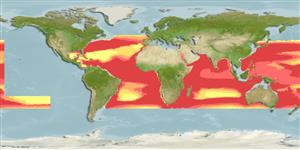Common names from other countries
Lớp phụ Cá sụn (cá mập và cá đuối) (sharks and rays) >
Squaliformes (Sleeper and dogfish sharks) >
Dalatiidae (Sleeper sharks)
Etymology: Squaliolus: Diminutive of squalus (L.), a sea-fish, usually applied to sharks, referring to small size of S. laticaudus. (See ETYFish); laticaudus: latus (L.), wide or broad; cauda (L.), tail, referring to its broad (but short) caudal fin. (See ETYFish).
More on authors: Smith & Radcliffe.
Environment: milieu / climate zone / depth range / distribution range
Sinh thái học
Biển Tầng nổi biển sâu; Ở đại duơng, biển (Ref. 51243); Mức độ sâu 200 - 1200 m (Ref. 27000). Deep-water; 48°N - 40°S, 180°W - 180°E
Nearly circumtropical. Western Atlantic: off Bermuda, southern Brazil, and northern Argentina. Eastern Atlantic: off France and Madeira. Western Indian Ocean: off Somalia. Western Pacific: Japan, Taiwan and Philippines (Ref. 13748), as well as Australia (Ref. 7300).
Length at first maturity / Bộ gần gũi / Khối lượng (Trọng lượng) / Age
Maturity: Lm 18.5, range 17 - 20 cm
Max length : 22.0 cm TL con đực/không giới tính; (Ref. 247); 25.0 cm TL (female)
Các tia vây lưng cứng (tổng cộng) : 1; Tia cứng vây hậu môn: 0. The spined pygmy shark Squaliolus laticaudus is a very small dogfish (about 25cm) with a large eye (diameter 73-86% of interorbital width), upper margin nearly straight; upper lip without papillae (Ref. 31367, 6871). Color: dark with conspicuously light-margined fins (Ref. 247) . Edge of fins with bright border (Ref. 43998).
S. laticaudus is the type species of the genus which has the following distinctive features: fin spine on its first dorsal fin but not on its second dorsal fin; second dorsal fin long-based and low, about twice the length of first dorsal fin base; first dorsal-fin base closer to pectoral fins than to pelvic fins; and caudal fin nearly symmetrical, paddle-shaped, with subterminal notch present; low lateral keels on caudal peduncle . Body cigar-shaped; snout very long, bulbously conical but slightly pointed; mouth ventral; lips thin; teeth strongly different in both jaws, uppers small, narrow and erect cusps, lowers larger, blade-like and semi erect. Tooth rows 22-23/16-21. (Ref. 247, 6871).
An oceanic, wide-ranging, tropical pelagic species occurring near continental and insular land masses, sometimes over the shelves, but usually over the slopes (Ref. 247). Displays vertical migrations on a diel cycle, seen at the bottom during the day and travels to 200 m at night (Ref. 247). Feeds on deepwater squid, lanternfish, gonostomatids and idiacanthids, and probably follows its prey on their diel migrations (Ref. 247). Ovoviviparous (Ref. 205). Has well-developed photophores densely covering the ventral part of the body and sparsely seen on the sides and hardly developed on the dorsal surface (Ref. 247).
Life cycle and mating behavior
Maturities | Sự tái sinh sản | Spawnings | Egg(s) | Fecundities | Ấu trùng
Probably ovoviviparous. Twelve mature eggs have been found in a single ovary of a mature female but this does not imply that large litters are produced (Ref. 247). Distinct pairing with embrace (Ref. 205).
Compagno, L.J.V., 1984. FAO Species Catalogue. Vol. 4. Sharks of the world. An annotated and illustrated catalogue of shark species known to date. Part 1 - Hexanchiformes to Lamniformes. FAO Fish. Synop. 125(4/1):1-249. Rome, FAO. (Ref. 247)
IUCN Red List Status (Ref. 130435)
CITES (Ref. 128078)
Not Evaluated
Threat to humans
Harmless
Human uses
Các nghề cá: không ích lợi (thú vị)
Các công cụ
Special reports
Download XML
Các nguồn internet
Estimates based on models
Preferred temperature (Ref.
115969): 7.1 - 14.6, mean 10 (based on 649 cells).
Phylogenetic diversity index (Ref.
82804): PD
50 = 0.7520 [Uniqueness, from 0.5 = low to 2.0 = high].
Bayesian length-weight: a=0.00372 (0.00141 - 0.00976), b=3.12 (2.89 - 3.35), in cm Total Length, based on LWR estimates for this (Sub)family-body shape (Ref.
93245).
Mức dinh dưỡng (Ref.
69278): 4.2 ±0.73 se; based on food items.
Thích nghi nhanh (Ref.
120179): thấp, thời gian nhân đôi của chủng quần tối thiểu là 4.5 - 14 năm (Fec assumed to be <10).
Fishing Vulnerability (Ref.
59153): Low vulnerability (15 of 100).
